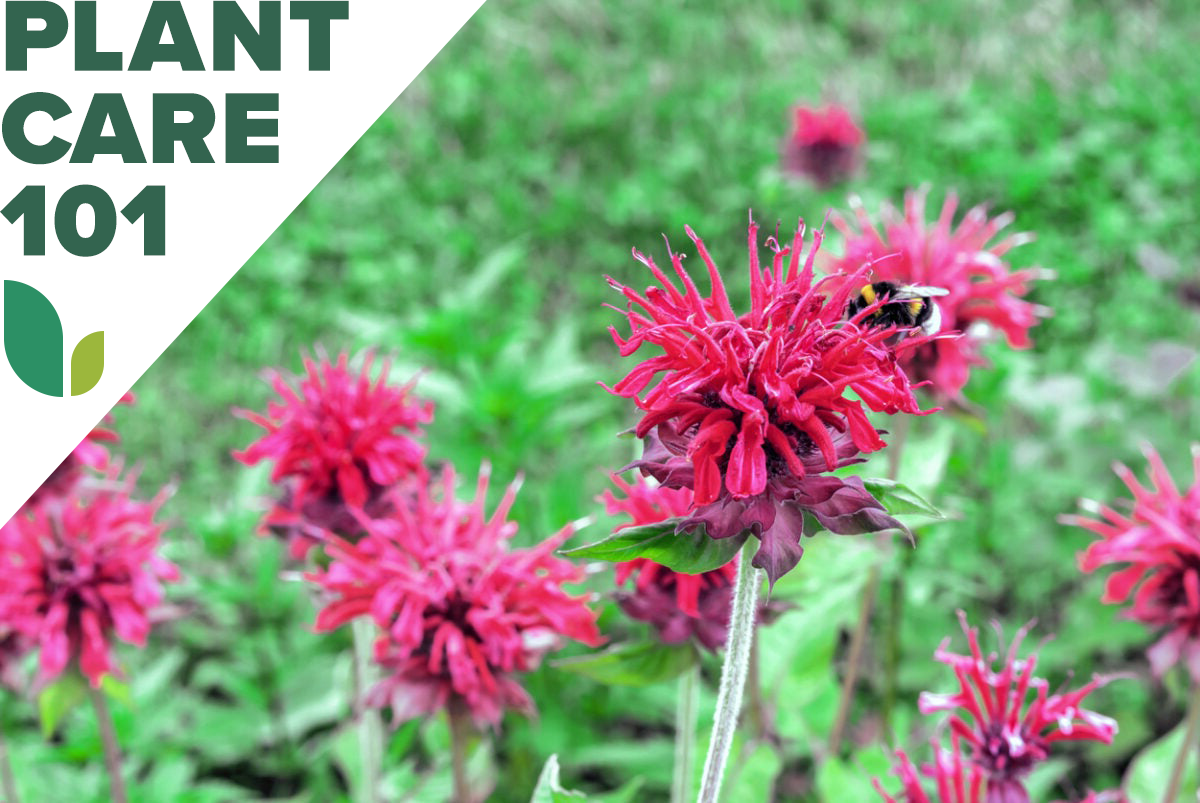

We may earn revenue from the products available on this page and participate in affiliate programs. Learn More ›
The bee balm plant is an endemic North American native. This flowering perennial will not only return year after year, but it will also spread because it self-sows. A member of the mint family, bee balm goes by many names, including Oswego tea, horsemint, and bergamot.
Loved by gardeners because it’s one of the best hummingbird plants and also attracts butterflies, bee balm also curries favor for its fragrant foliage and whorled blooms in red, pink, purple, or white. An easy-care plant, it can grow up to 4 feet tall, with a spread of 3 to 4 feet.
RELATED: How To Get Rid of Bees (Without Harming Them)
Growing Bee Balm at a Glance
Common Name: Bee balm
Scientific Name: Monarda didyma
Hardiness Zone: Zones 3 through 9
Soil: Rich, organic, well-draining soil; pH 6.0 to 6.7
Light: Full sun, but will tolerate part shade
Water: Likes to be evenly moist, but not overly wet; drought-tolerant
Food: Balanced fertilizer or from soil amended with compost, manure, or other organic material
Propagation: Seed, stem cuttings, or division
Safety: Nontoxic to people and animals
Bee Balm Characteristics
Bee balm, or Monarda, displays loose, mop-like flower heads with tubular petals in red, pink, purple, or white. A member of the mint family, it has a minty or citrusy scent that repels mosquitoes but attracts the pollinators it feeds, including bees, butterflies, and hummingbirds. Although this North American native perennial attracts more butterflies and hummingbirds than it does bees, it gets its name from historic use as an antidote for bee stings.
Preferring full sun, the fast-growing bee balm tolerates partial shade, particularly in hot regions, although it is not one of the best flowering plants for shade. It likes moist soil, but not “wet feet.”
Because Monarda spreads by self-seeding and underground rhizomes, it will need to be divided every few years to keep it looking its best. Deadhead bee balm for continuing blooms.
Recommended Bee Balm Varieties
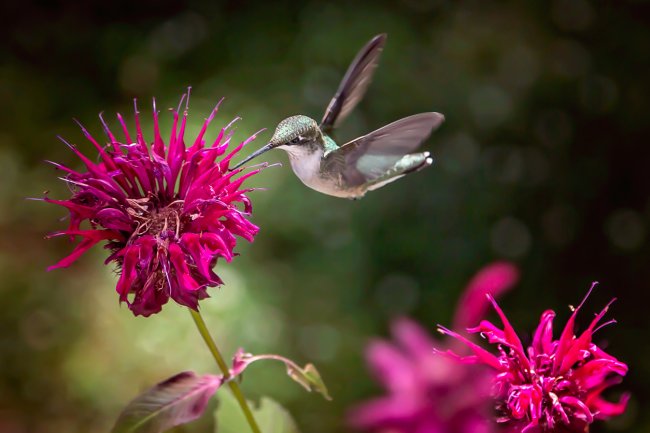
Bee balm is a standout among plants that attract hummingbirds and butterflies. Interbreeding species resulted in the development of at least 50 commercial cultivars of bee balm. Here are a few popular varieties:
- Lemon bee balm (Monarda citriodora) hails from the rocky prairies and dry pastures of northern Mexico and the southern U.S. Tall, tubular flowers sit atop whorled stems.
- Eastern bee balm (Monarda bradburiana) is a variety that produces light pink to white spotted flowers lasting all summer and aromatic, oblong leaves.
- Scarlet bee balm (Monarda didyma), which means twins, gets its name from its stamens that grow in pairs, and it has a bright-red flower to attract pollinators. The most common variety found in the wild, it’s used in teas and essential oils.
- Wild bergamot bee balm (Monarda fistulosa) has flowers that are reddish-purple and open from the center. Endemic to eastern Canada and the U.S., this plant grows 3 feet high, with hairless upper stems and lance-shaped leaves that have a distinct oregano aroma when crushed.
- Violet Queen bee balm (Monarda ‘Violet Queen’) is a hybrid that produces lavender-pink blooms in midsummer and is well suited to growing in pots and borders.
RELATED: The 12 Biggest Landscaping Trends for 2022
Planting Bee Balm
Bee balm can be a great addition to a pollinator garden, a flower bed, or a container garden. Because it needs periodic dividing, there’s plenty to plant. Here are some suggestions about how and when to plant bee balm.
When is the best time to plant bee balm?
The best time to plant bee balm is in the spring once all chance of frost has passed, or in the fall before your first frost date. If planting this fast-growing perennial in the fall, trim the foliage to encourage the plant to direct its energy to establishing roots in its new spot.
Where can bee balm grow?
Bee balm can grow in sunny locations with moist, rich soil that drains well. It can tolerate partial shade, particularly in hot climates. It works well toward the back of borders behind low-growing annuals or perennials that can hide its sparsely covered “legs,” but it shouldn’t be overcrowded.
Good choices for bee balm companion plants include variegated phlox, daylilies, peonies, roses, echinacea, black-eyed Susan, and, in the vegetable garden, squash and tomatoes.
How do you plant bee balm?
Planting bee balm is pretty straightforward. Here are some tips:
- Select a sunny spot with rich, moist (but not soggy) soil.
- Dig holes 18 to 24 inches apart.
- Cover with dirt and mulch before watering.
Can you grow bee balm in containers?
Bee balm can be successfully grown in containers, given the right conditions. Plant individually in a container that’s sized correctly, or plant as the centerpiece in a larger container or tub filled with companion plants in rich, organic soil. Because bee balm spreads and can reach 2 to 4 feet high, it should be planted in a 5- to 10-gallon pot that is crack-proof and weather-resistant.
Ensure proper drainage and place bee balm in a sunny setting where it will get good air circulation. Be certain to water when the top inch of soil feels dry because bee balm prefers not to be dry for too long. Water less often in fall as the plant prepares for hibernation.
Watering Bee Balm
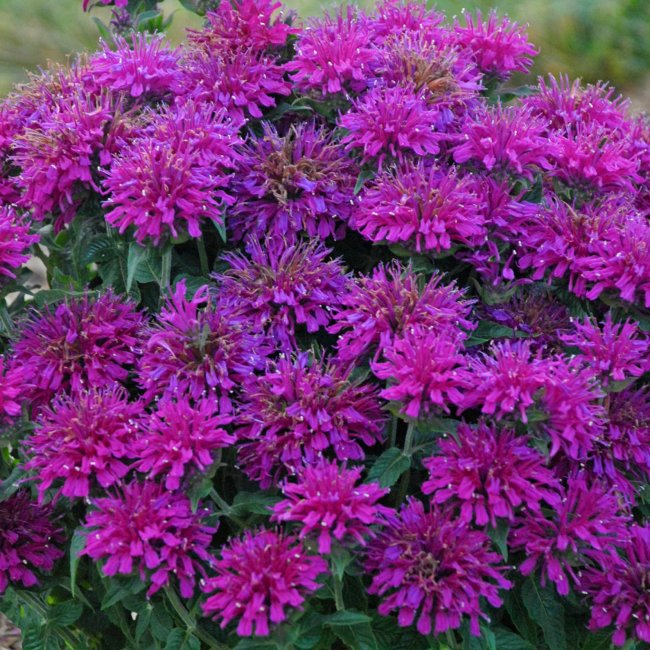
Bee balm plants like evenly moist soil that drains well. They do not like wet feet. Although bee balm can tolerate drought, especially once established, dry conditions can give rise to issues such as powdery mildew, fewer blooms, smaller leaves, and a generally weaker plant. Insufficient water results in leaf curl, drooping leaves, or brown or scorched leaves. Drought causes stress, resulting in slower root growth, smaller leaves, and fewer blooms.
Regular watering helps new plants develop a strong root system. Generally, bee balm requires about an inch of water per week. Overwatering can cause root rot and diseases such as mildew.
Fertilizing Bee Balm
If your soil has plenty of organic nutrients, you most likely won’t need to fertilize bee balm; the plants don’t require frequent or heavy fertilization. However, a small amount of a balanced 10-10-10 granular fertilizer administered in the spring shouldn’t hurt. Be careful not to overfertilize, though, because it will decrease flowering and could contribute to powdery mildew.
The addition of compost or manure in the spring can benefit both the soil and the bee balm plant.
Pruning Bee Balm
You can pinch back the top set of leaves when the plant reaches about 12 inches high if you want to encourage lateral growth. For broad swaths of bee balm, use shears to trim about half the height of the plants. This will help them from becoming lanky—a common issue with bee balm. If you don’t prune bee balm, you may want to stake plants to keep them upright.
When does bee balm bloom? It typically starts flowering in July, continuing through late summer. Thus, pruning early can encourage lateral growth that should produce more blooms.
After frost has killed foliage in late fall or winter, you should prune the dead foliage down to just above the soil line.
Propagating Bee Balm
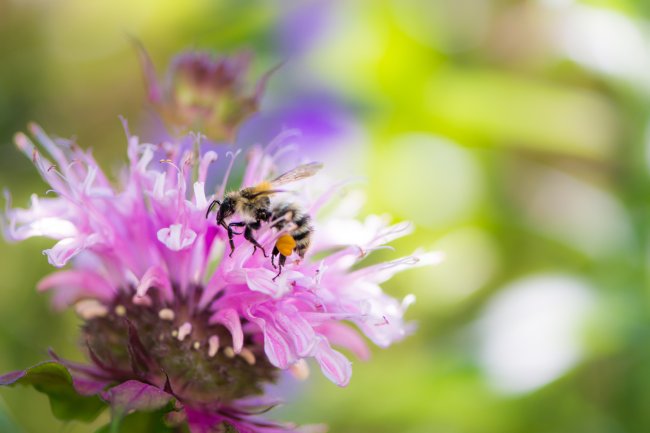
You can propagate using bee balm seeds, but since hybrids are not true to seed, the best method for predictable results is division.
In early spring, dig the rhizomes around the edge of the clump after new shoots have begun to break ground. Remove the dirt and either pull or cut clumps apart, leaving two or three shoots per divided clump. Division can reduce overcrowding and reinvigorate older plants, and it should be done every 2 to 3 years.
Take stem cuttings from new growth in late spring. Dip a 6-inch cutting in rooting hormone and place in a pot with perlite, vermiculite, and peat moss. Water and cover with plastic.
RELATED: How to Keep Bees Away From Hummingbird Feeders Without Harming Them
Safety Considerations
No parts of the bee balm flower or foliage are toxic to humans or animals. In fact, bee balm is used for teas and also for its antiseptic properties. All above-ground parts are edible. The leaves and flowers, which can be eaten raw or cooked, have a minty taste.
Although they may be attracted by its scent, dogs, horses, and most livestock typically don’t like the bitter taste of this herb. Cats are sometimes drawn to the strong citrus fragrance and flavor similar to oregano.
Potential Pests and Diseases
Powdery mildew is the most common fungal disease that attacks bee balm, leaving a telltale powdery white or gray residue on the leaves; humidity is usually the cause. The plant can be cut back to rid it of the issue. Alternatively, you can apply a fungicide or Neem oil, but the best treatment is prevention by providing sufficient air circulation and avoiding overhead watering.
Rust fungus sometimes occurs and is treatable with a fungicide. Root rot can occur if the soil doesn’t drain well.
Bee balm isn’t bothered by many pests because its scent repels them. However, stalk borers, spider mites, and thrips can be a problem. Borers tunnel into the stalk; destroying or removing the affected stalk can halt the problem, but if you miss it, the plant will wilt and die.
Spider mites suck out the plant’s juices, turning leaves yellow. They can also be detected by the fine webbing they manufacture. Insecticidal soaps and horticultural oils like Neem can kill them. Thrip damage looks similar, without the web.
Preparing Bee Balm for Winter
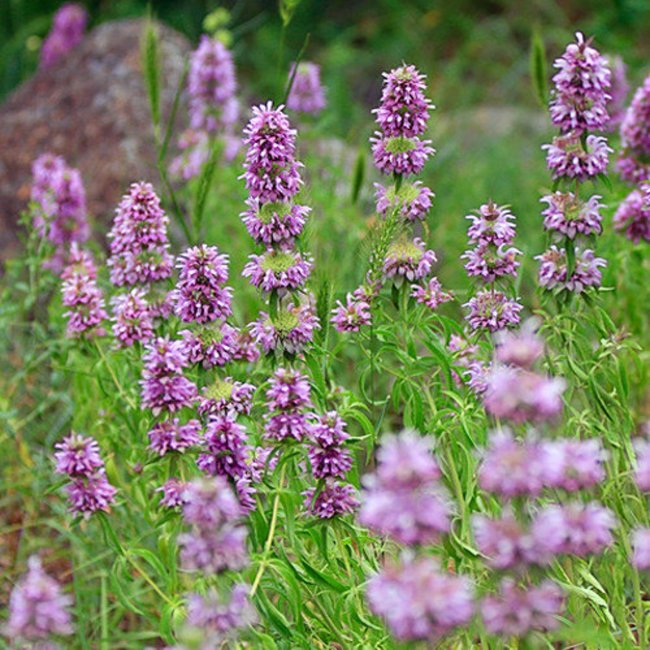
Once frost has killed the foliage in late fall or winter, cut stems back to 2 inches above the soil line. Remove debris to prevent fungal spores. If you don’t want bee balm to spread by self-sowing, cut the plant back before it drops seeds. If you want to encourage spreading—and if you want to provide winter food for the birds—leave the seed heads on the plants.
Unless located in a hardiness zone with extremely cold winter temperatures, no protection is necessary. In cold climates, mulch the crown to protect the roots against freeze-thaw cycles. Remove the mulch in the spring.
Looking for more pollinator-attracting plants? Check out our guides on growing milkweed, lantana, and zinnias.
